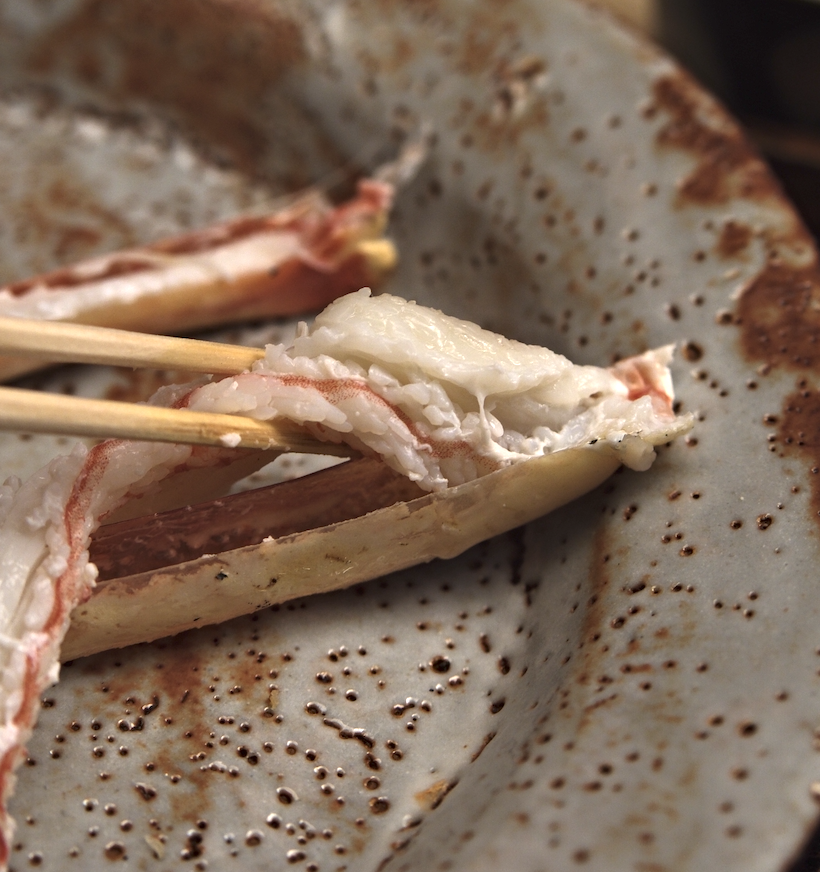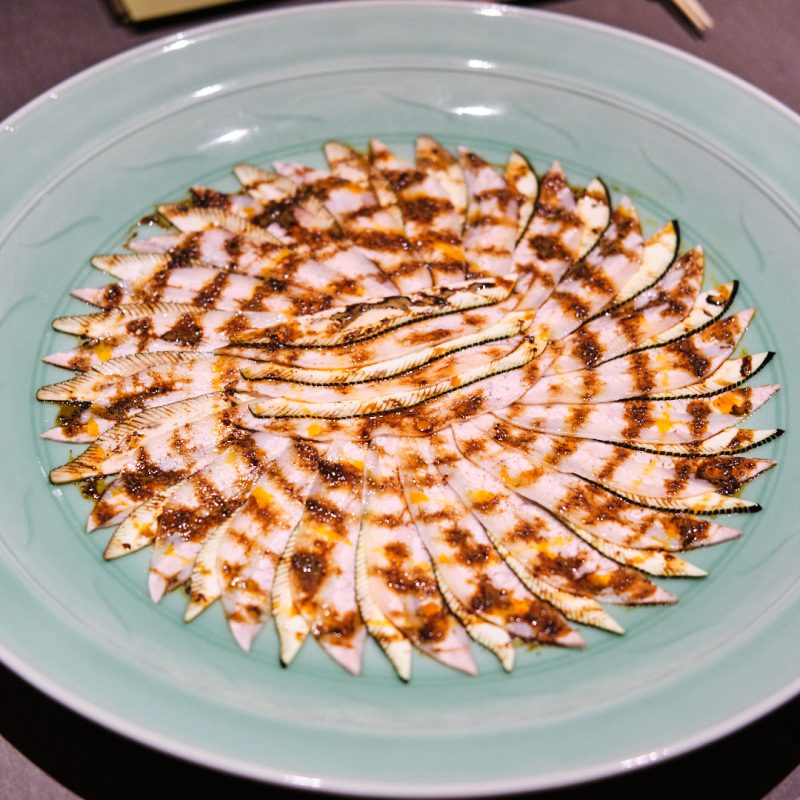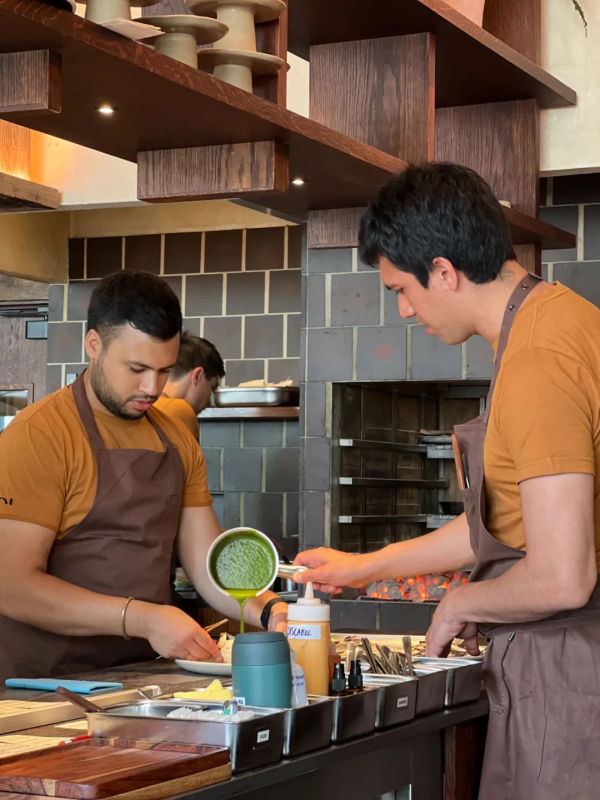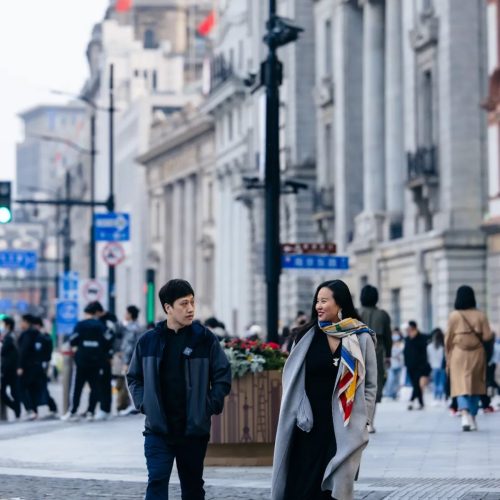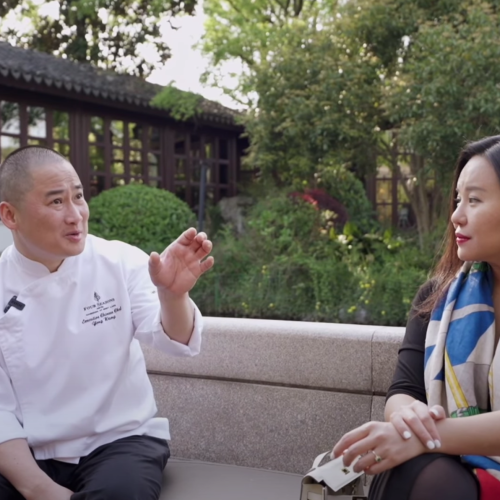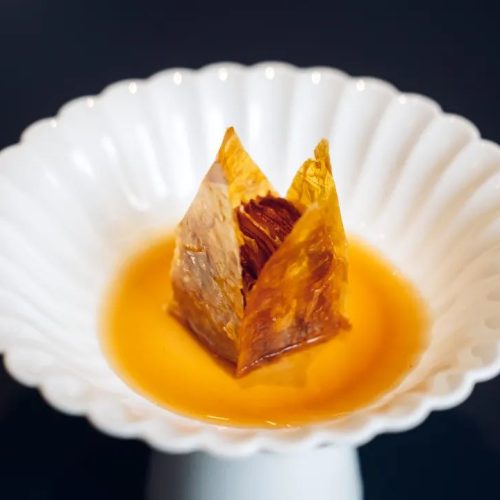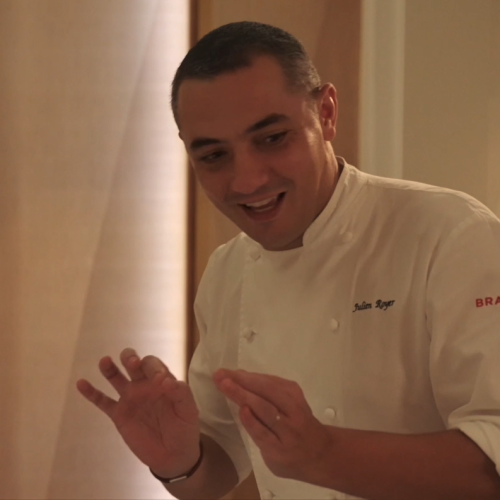When I visited Kyoto in mid-December, I had the chance to visit Ogata,a two-Michelin-starred kaiseki restaurant and experience its seasonal crab menu. Every year, November 6th marks the start of the crabbing season, meaning that it’s the time for the restaurants to launch their seasonal crab feast. Kyoto’s “Taiza crab” refers specifically to Matsuba crabs caught exclusively at Taiza Port on the Tango Peninsula in northern Kyoto. With only five boats permitted to catch the crabs there and stringent selection criteria for appearance, size, and meat quality, “Taiza crab” is often referred to as the “phantom crab” for its rarity and exceptional quality.
Ogata is located near Shijo Street in the center of Kyoto, tucked away at the end of a stone-paved path. The restaurant’s understated entrance features a simple sign with the characters “Ogata” and a dimly lit lantern. Seated at the counter, guests are treated to a view of a serene garden adorned with vibrant red maple leaves through floor-to-ceiling windows. Chef Toshiro Ogata, originally from Hiroshima, honed his craft as head chef at the renowned kaiseki restaurant Wakuden in Kyoto for over a decade before establishing Ogata in 2008. Since 2010, the restaurant has consistently held two Michelin stars. Known for its reliance on Kyoto’s seasonal ingredients, Ogata emphasizes unembellished presentation, letting the natural flavors shine.
 Ogata’s Chef: Toshiro Ogata
Ogata’s Chef: Toshiro Ogata
The meal began with deep-fried female Taiza crab (Koppe Kani), almost like an elevated tempura. The fist-sized crab shell was filled with luscious crab roe and meat, lightly battered and fried to perfection. The crispy coating complemented the roe’s chewiness and the rich crab flavor, creating an unforgettable bite. Served alongside piping hot, glistening ginkgo nuts, the dish was a delightful start of the meal.
The chef explained that while the crabbing season spans five months (November to March), Ogata only offers its crab menu from November to end of December. This is because these are the only two months when guests can enjoy both male and female Taiza Crabs at their peak, since the flavor of female crabs wanes after December. Hearing this, I felt incredibly fortunate to be here at the best time.
 Deep-Fried Female Taiza Crab
Deep-Fried Female Taiza Crab
Winter is the best time to have turnips. At Ogata, a ball of rice was topped with pureed turnip, covered by thickened dashi, and garnished with a touch of wasabi (Appearance-wise, it really looked like “shinjō” in traditional Japanese cuisine ) .The turnip’s natural sweetness blended seamlessly with the delicate broth, while the soft rice grains added an elegant, refined taste. The chef thoughtfully thickened the dashi sauce to a jelly-like consistency to retain warmth, an especially considerate touch on a near-freezing winter night.
After two warm appetizers, the meal transitioned to some cold dishes. First came kobujime red seabream, amadai, and cured mullet roe, followed by Yaito Katsuo Sashimi. Though similar in appearance to regular katsuo (Skipjack Tuna), Yaito Katsuo’s vibrant red flesh was interspersed with more distinct marbling, resulting in a luxurious mouthfeel. Aside was some soy sauce with chopped green onions, which is relatively rare to see in traditional Japanese Cuisine, but went super well with the sashimi. In fact, the richness and sweetness of Yaito Katsuo was even more elevated, which made myself wonder if I was actually having Chutoro ( medium-fatty tuna belly) instead.
Then here comes the star of the night:Taiza crab. Crab legs were charcoal-grilled with their juice sizzling, filling the room with their aroma. One chopstick could easily scrape out the succulent meat from the shell, and no need to mention how incredibly sweet and juicy the meat was. A squeeze of sudachi added a little twist that makes the flavor a bit brighter. We also had raw crab claws that matched perfectly with the ginger soy sauce – so soft, sweet and smooth. Remarkably, after devouring different parts of the crab, my fingers bore no trace of seafood smell, a testament to the crab’s unparalleled quality.
 Raw Crab Claw
Raw Crab Claw
Finally, the “crab miso”(crab innards) arrived — the dish that I was looking forward to the most. Crab shells were filled with the dark green, umami-rich crab innards, gently heated over the grill. We then scraped some crab leg meat into it and let the crab leg soak up all the crab miso. To me it was almost like eating the Tsukemen (Dipping Noodles), but of course the Ogata-only-all-crab version. When the crab miso was almost finished, the chef poured in some warm sake, instructing us to stir and mix the sake with the leftover crab miso. This immediately reminded me of the “Deglaze” technique of French culinary techniques. The resulting “sake crab soup”, warm and brimming with crab essence, was sipped to the last drop, leaving us cozy and slightly tipsy.
 Crab Miso
Crab Miso
As the crab course concluded, Kyoto’s famed winter vegetable, ebi imo (shrimp-shaped taro), made its appearance. Named for its curved, shrimp-like shape, ebi imo is denser and creamier than other taro varieties. After a long simmer, it retained its firm texture, melting like butter on the tongue when paired with a delicate dashi broth. In fact to me, its natural sweetness and flavors were much more similar to sweet potatoes instead of taro. Despite feeling full, the eight guests at the counter finished every bite.
For dessert, Ogata showcased a unique Kyoto ingredient—Daishiro persimmon. These Nara-grown Edo persimmons are transported to Kyoto, where they undergo a 2-3 day process in a room filled with specific gases to remove their astringency, leaving the center of the persimmons soft, translucent, and jelly-like. The naturally sweet, tender fruit required no effort to scoop out with a spoon, and its sugary flavor was so intense that it seemed as though sugar had been added—even the core was sweet as candy!
In my opinion, no matter how many photos or videos we took, none of them could do Ogata any justice. Chef Ogata’s composed presence and masterful handling of ingredients at the counter was a performance itself, not to mention all the flavors and textures that could never be captured. I wouldn’t say his dishes are instagrammable, but all of them delivered unparalleled flavors, embodying the philosophy of “less is more.” At Ogata, the finest ingredients were treated in the very best way to be presented with simplicity and precision, and anything else would be extra.
As we left the restaurant, Chef Ogata walked us off the door and waved us goodbye. The enchanting Kyoto night, combined with the unforgettable Taiza crab feast, made it a truly perfect evening.

Text & Images: Patty Chuang

